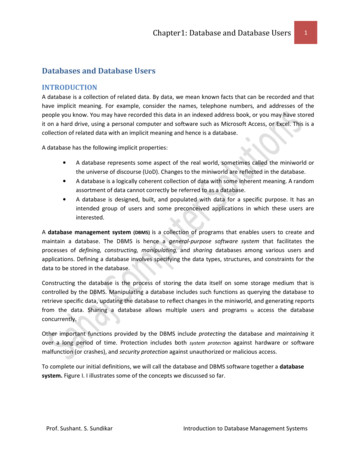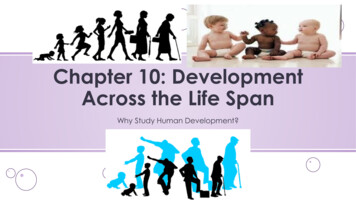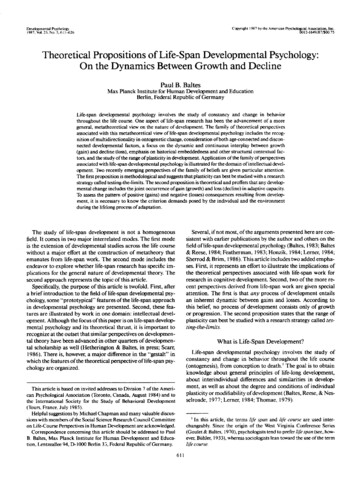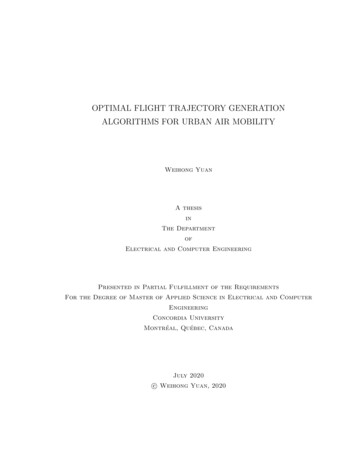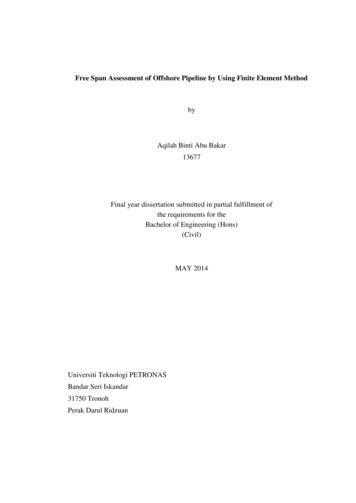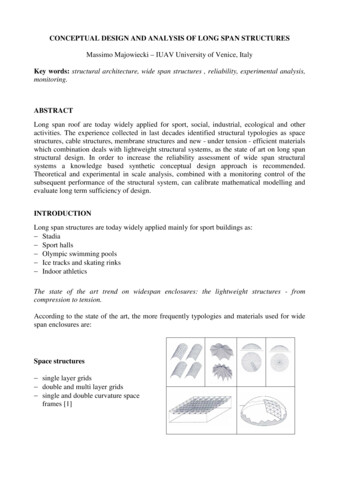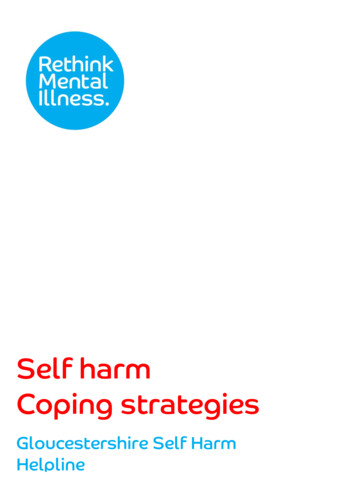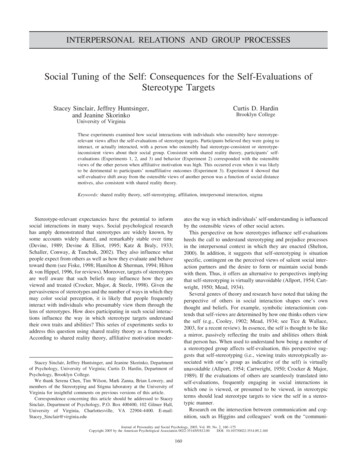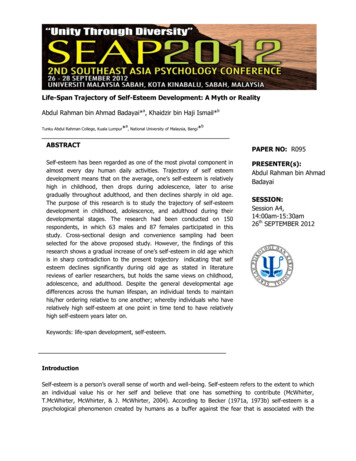
Transcription
Life-Span Trajectory of Self-Esteem Development: A Myth or RealityAbdul Rahman bin Ahmad Badayai*a, Khaidzir bin Haji Ismail*babTunku Abdul Rahman College, Kuala Lumpur* , National University of Malaysia, Bangi*ABSTRACTSelf-esteem has been regarded as one of the most pivotal component inalmost every day human daily activities. Trajectory of self esteemdevelopment means that on the average, one’s self-esteem is relativelyhigh in childhood, then drops during adolescence, later to arisegradually throughout adulthood, and then declines sharply in old age.The purpose of this research is to study the trajectory of self-esteemdevelopment in childhood, adolescence, and adulthood during theirdevelopmental stages. The research had been conducted on 150respondents, in which 63 males and 87 females participated in thisstudy. Cross-sectional design and convenience sampling had beenselected for the above proposed study. However, the findings of thisresearch shows a gradual increase of one’s self-esteem in old age whichis in sharp contradiction to the present trajectory indicating that selfesteem declines significantly during old age as stated in literaturereviews of earlier researchers, but holds the same views on childhood,adolescence, and adulthood. Despite the general developmental agedifferences across the human lifespan, an individual tends to maintainhis/her ordering relative to one another; whereby individuals who haverelatively high self-esteem at one point in time tend to have relativelyhigh self-esteem years later on.PAPER NO: R095PRESENTER(s):Abdul Rahman bin AhmadBadayaiSESSION:Session A4,14:00am-15:30am26th SEPTEMBER 2012Keywords: life-span development, self-esteem.IntroductionSelf-esteem is a person’s overall sense of worth and well-being. Self-esteem refers to the extent to whichan individual value his or her self and believe that one has something to contribute (McWhirter,T.McWhirter, McWhirter, & J. McWhirter, 2004). According to Becker (1971a, 1973b) self-esteem is apsychological phenomenon created by humans as a buffer against the fear that is associated with the
knowledge of the inevitability of one’s death. On the other hand, self-esteem is also been regarded as aculturally based construction that consists of viewing oneself as living up to specific contingencies ofvalues, which are derived from culture at large but are integrated into a unique individualized worldviewby each person (Pysczynski, Greenberg, Solomon, Arndt, & Schimel. 2004).For decades, researchers have tried and debated to proved the self-esteem should be thought ofas a trait-like construct that remains stable overtime or state-like construct that continuously fluctuates inwhich it interacts with the environment and situational changes and demands (Trzesniewski, Donnellan,& Robins, 2003; Robins & Trzesniewski, 2005). It is stated that self-esteem is trait-like construct which isbased on the meta-analysis results (Trzesniewski, Donnellan, & Robins, 2003; Roberts & DelVecchio,2000). Thus, an individual who has relatively high self-esteem at one point in life tend to have high selfesteem years later; likewise those with low self-esteem earlier in life tend to have low self-esteem yearslater. Similarly, the trajectory of self-esteem across the life-span is more stable in some periods of lifethan in others. This fluctuation and stability seems to be relatively low in early childhood, increases inadolescence and early adulthood, and then declines in midlife and old age. (Robins & Trzesniewski, 2005)As an individual grows up and experience the life course, his or her self-esteem inevitably waxesand wanes. These fluctuations in self-esteem reflect changes in social environment as well asmaturational changes taken place such as an onset of puberty; mostly by the physical changes andcognitive declines in old age. Thus, when these changes are experienced by most individuals at about thesame age across the life-span and influence individuals in a similar manner, they will produce normativeshifts in self-esteem trajectory across developmental periods. (Robins & Trzesniewski, 2005)However, much of the studies concerned about self-esteem is a distinctly an Americanphenomenon, in which it reflects an individualistic culture (Matsumoto & Juang, 2008; Bellah et al., 1985).Thus, the differences and gap can be seen even greater for non-Western countries (Whiting & Edwards,1988) as the Americans value high self-esteem to a greater extent than people in other countries(Matsumoto & Juang, 2008; Triandis, 1995). For instance, the Japanese culture, self-criticism is a virtueand high self-esteem is seen as a character problem (Heine, Lehman, Markus, & Kitayama, 1999). Theexpression of cultural ideologies may serve as a function of enhancing or reinforcing self-esteem asderived from cultural issues, thus contributing to the feeling of one’s uniquely human existence(Matsumoto & Juang, 2008).Prior to the above discussion, the researchers will be discussing the life-span trajectory of selfesteem development as well as ethnic and gender differences. The discussion also will take into accountsome critical analysis on the trajectory of self-esteem development in every single aspect of humandevelopment, in which hopes to answer the myth or reality of self-esteem essentialism.Methods Research designA survey was conducted to collect the data for this research. A set of Rosenberg Self-Esteemquestionnaires was distributed amongst 150 respondents (N 150: 63 males, 87 females). Cross-sectionaldesign and convenience sampling were selected for the purposed study.
ParticipantThe participants consisted of 150 individuals (63 males, 87 females). The participants were divided intofive cohorts; childhood, adolescence, early adulthood, middle adulthood, and late adulthood (old age).The participants were recruited from Klang Valley and Kuantan district (Malaysia). InstrumentSelf-esteem was assessed with the 10-item Rosenberg Self-Esteem Scale (RSE), the well-validatedmeasure and most commonly used of self-esteem questionnaire. Responses were measured with a 4point scale, ranging from 1 (strongly disagree), 2 (somewhat disagree), 3 (somewhat agree), and 4(strongly agree). The reliability of the RSE was consistently 0.86. The RSE was translated to Malaylanguage by using back translation and had been proofread before it was distributed amongst therespondents.Results and dMiddleAdulthoodLateAdulthoodFig. 1: Mean level of self-esteem across the life-span; childhood, adolescence, adulthood, and old age.There are a number of developmental reasons why self-esteem might follow the developmental patternof a decline in early adolescence followed by a rise in late adolescence and emerging adulthood.Based on the normative studies (Robins & Trzesniewski, 2005), self-esteem during childhoodrelatively high because they tend to make unrealistically favorable self-attributes and overestimate theirown abilities. Thus, children mostly rely on the external comment and social comparisons in order to formmore accurate appraisal of their competences and abilities (Johnson, 2011). Furthermore, Davis-Keanand Sandler (2001) assumed that children’s evaluation of self is not sensitive to specific context, and asthe consequence, the measures of self-esteem in children typically make little distinction betweencontexts of self-esteem in children; school, home, peer. Thus, from the above finding, the mean-level ofself-esteem in childhood is relatively higher then adolescence (M 2.13, SD 0.63).Kail and Cavanaugh (2009) stated that, as children progress through primary school to secondaryschool, self-esteem becomes particularly well defined. However, as they reached adolescence, selfesteem continues to decline. This can be seen in the above figure 1 as clearly stated that the mean-level
of self-esteem in adolescence is (M 2.07, SD 0.44). Several reasons to explain the finding, it could bedue to the onset of puberty, adolescence might experience either negative or positive occurrence as wellas continues to receive negative feedbacks and comments on his or her physical appearances, academicachievement, peer relationships and so on. This transition can be more challenging and socially complex,thus it might lead to storm and stress period. Moreover, Dhal, Bhatia, Sharma, and Gupta (2007) alsostated that early adolescents reported higher self-esteem as compared to later adolescents, which holdsthe same views with previous researches.Although self-esteem tends to decline from preadolescence to adolescence, to some people itrises during emerging adulthood (Arnett, 2009). There are a number of reasons why self-esteemincreases over this period (young adulthood). Physical appearance is important to adolescents’ selfesteem, and by emerging adulthood, they have passed through the awkward changes of puberty andhave gained self-confidence in how they look (Arnett 2003; Galambos et al., 2006; O’Connor, Allen, Bell& Hauser, 1996). Others such as feeling accepted and approved by parents, in which consequently therelationship between parent-child generally improve, leaving the social pressure and evaluation by peersand friends, and lastly the ability to reach more control over social contexts of everyday life (Arnett,2009; Gavin & Furman, 1989). Over the course of adulthood, individuals increasingly occupy positions ofpower and status, which might in returns promote feelings of self-worth. Many theorists have suggestedthat, midlife is characterized by peaks in achievement, mastery, and control over self and environment(Robins & Trzesniewski, 2005). This somewhat true as stated in the findings, in which the mean-level ofself-esteem in early adulthood (M 1.97, SD 0.49) gradually increases and reaches its peak in middleadulthood (M 2.07, SD 0.37).Self-esteem in old age starts to decline. The declination may be due to the dramatic confluenceof changes that occur in old age such as physical functioning (e.g., health problems), changes in roles(e.g., retirement), socioeconomic status or even relationship (e.g., the loss of a spouse) (Robin &Trzesniewski, 2005). Moreover, certain domain-level in self-esteem such as, physical self-worth,perceived attractiveness, strength, and condition are anticipated to decrease one’s self-esteem level, andthus change the trajectory. (Gothe et al., 2011)However, the finding indicated the contradicting result, in which the self-esteem in old agecontinues to incline (M 2.3, SD 0.53). This could reflect a shift toward a more modest, humble, andbalanced view of the self in old age. Nevertheless, individuals in old age who accept and internalize theoccurrences and changes positively and regard it as natural causes, might well accept his or herconditions in old age. Many assume that the personal and social losses at old age associated withdeterioration of one’s well-being subsequently lead to the decline of self-esteem. However, one mayknow not that to some aging adults, can negotiate the many threats presented to living a long life andthus, to gain perfect and blissful life experiences.
Males67%60%33%40%LowFemalesModerate61%39%HighFig. 2: Mean level of self-esteem between genders. Also plotted are differences by level of self-esteem;low, moderate, and high, separately for males and females.Generally, the overall self-esteem trajectory of males and females are similar. For both genders, selfesteem is relatively high in childhood, drops during adolescence and rises in adulthood. However, in thefindings, females show significantly higher score of self-esteem in moderate level (60%) and high level(61%). On the other hand, males’ score higher in low level of self-esteem (67%). These findings yetagain contradict the literature, as stated by Kling, Hyde, Showers and Buswell (1999); Robins,Trzesniewski, Tracy, Gosling, and Potter (2002), a gender gap emerges by adolescence, such thatadolescent boys have higher self-esteem than adolescent girls. This gap seems to be persistentthroughout adulthood and disappears towards the old age (Kling et al., 1999; Robins, Trzesniewski, Tracy,Gosling, & Potter, 2002). As such, the distinction of level of self-esteem between males and femalescould be caused by different emphasis on different domains such as physical appearance, socialacceptance, behavioral conduct, academic achievement, and so on (Arneet, 2009). For instance, thishelps explain why girls’ self-esteem in physical domain is more likely to decline as they enter earlyadolescence. Reaching puberty means becoming more womanly, and its mean gaining more weight.Numerous explanations would be sensible to explain the gap between genders differences. Theranging from the onset of puberty and maturational changes in physical, emotional, cognitive and socialcontextual factors always associated with these differences. Moreover, the self-esteem could also becaused by the occurrences experienced by both males and females, such as storm and stress periods andpositive life development through the adolescence life. These depend on the social-environment contextsin which the adolescents live in.
eIndianOthersFig. 3: Mean level of self-esteem between ethnic groups.The above finding shows that, there are no significant differences on self-esteem level acrossethnic groups; Malay, Chinese, and Indian. The other ethnic groups (other than Malay, Chinese, andIndian) show a sharp decline. Even so, the self-esteem of all ethnic groups is relatively high. There arenumerous findings on the culture and ethnicity on self-esteem. Early cross-cultural researches on selfesteem, reported that members of individualistic cultures, such as Americans and Canadians areaccentuated on the importance of self-enhanced, however not for Asians (Matsumoto & Juang, 2008).Even amongst those in collectivistic culture, such as Japanese, Chinese, Malay, Indian and so on mighthave some gap in regards to the domain of self-esteem. This might be caused by the specific-culturalenvironmental context in which they live in.Despite the fact that members of individualistic culture value self-enhance than Asians, recentresearch strongly suggests that people of either collectivistic or individualistic cultures express or valueself-enhance in different ways. For instance, certain domain of self-esteem might be treated and judgeddifferently in different contexts (Heine, 2005). Another research conducted by Tafarodi and Swann (1996),found that Chinese students were lower in self-competence, but high in generalized self-liking. Thus, it issupport the notion that self-esteem may have multiple facets, and also the perceptual differencesbetween individualistic and collectivistic cultures (Matsumoto & Juang, 2008).In addition, Arnett (2009) also stated that, differences in self-esteem might be seen in differentdomain such as in physical appearance. African American females evaluate their physical appearancequite differently compared to White females do (Dubois et al., 1996; Greene & Way, 2005; Mendelson etal., 2000). Moreover, some findings suggested that Asian and Black young women evaluated themselvesaccording to skin color, as with those relatively dark skin might having negative perceptions of theirattractiveness (Bond & Cash, 1992; Sahay & Piran, 1997). Consequently, the ethnic and culturedifferences in perceived physical appearance supports the belief that cultures somehow significant to thedifferent level of self-esteem.Critical Analysis on the Trajectory of Self-esteem DevelopmentTo some extent, people might refute self-esteem as a mere bogus of self-evaluation that has lesssignificance on an individual’s life-span. Until today, the self-esteem had been caught in a quagmire of
conflicting findings. Despite the arguments on the developmental trajectory, self-esteem still can be seenas the key indicator to life successes and catastrophes. These successes and devastations experienced byone in his or her life would be much pretentious by individual’s level of self-esteem. Prior to that, selfesteem has usually been regarded as a cause than consequence factor (Orth, Robins & Widaman, 2012).The question of either self-esteem is a cause or a consequence yields a great deal amongst scholarsespecially in the interventions that aimed at boosting self-esteem. Many studies on self-esteem are basedon correlational design. Means that, a correlation between X and Y could mean that X causes Y and viceversa. If only self-esteem causes an assortment of positive outcome, then it will be worth to instill highself-esteem into children or vulnerable at-risk adolescents. In contrast, if the self-esteem is an outcomeof life achievement or good behavior, then it is insignificant to raising self-esteem (Baumeister, Campbell,Krueger & Vohs, 2003).Therefore, if the self-esteem is an outcome rather than cause, then it could flop and lead toproduce undesirable effects. For instance, working hard in college or university leads to a good grade,subsequently it will lead to high self-esteem. Noted, that high self-esteem of feeling good serves aspivotal reinforcement to study hard, which in turns lead to academic success. If only a programintervenes to promote high self-esteem amongst students regardless of their academic performance, thenthe students would relish the rewards of self-esteem without making any effort. As such, the debates ofself-esteem either a cause or a consequence remain vague and uncertain. Thus, auxiliary and extensiveresearch could be carried out to certainly answer the question of either cause or consequence.Regardless of the cause and consequence issue of self-esteem, the researchers found that theself-evaluation of either someone is good, bad, excellent or vice versa is a mere cognitive reflections. Thishas been long-established by Baumeister, Campbell, Krueger, and Vohs (2003) asserted that, self-esteemis a perception rather than reality. It refers to a person’s belief and perception about one’s ability andcapability in life. The belief that people might have shape his or her actions in many ways, and thus theseactions in turn would shape the individuals’ social reality of the people around them. This belief can befabricated or even factual about one’s self.Nevertheless, self-esteem could also be the product of environmental conditions and social lifeevents that might influence the level of one’s self-esteem over time. Hence, self-esteem is formedthrough experiences with the environment and is especially influenced by environmental reinforcementsand significant others (Johnson, 2011; Dhal, Bhatia, Sharma & Gupta, 2007). Thus, it can be understoodthat, there are third variable that could lead to the discrepancy of life-span trajectory of self-esteemdevelopment. On the other hand, different notions about self-esteem lead to different conclusion on theeffects and impacts of self-esteem have on individual’s life and thus different understandings that wehave on the self-esteem development.Apart from that, one critical question to be answered is, does self-esteem development has auniversal trajectory across the life-span? The trajectories of self-esteem throughout the life-spandevelopment are waxes and wanes. As the result, it leads to the high and low scores of self-esteem atcertain point of age in one’s life-span. The exact pattern of the trajectory of self-esteem developmentseems to be disagreement amongst scholars.Remarkably, the researchers did not find any universal trajectory or normative curve of selfesteem in any existing literatures. Many possible reasons could be used to explain the discrepancies of
the self-esteem trajectory development. Firstly, different types of instruments, different items were usedto measure self-esteem. For instance, Rosenberg Self-Esteem Scale (RSE), Single-Item Self-Esteem Scale(SISE) and Coopersmith Self-Esteem Inventory (CSEI). Some items are more sensitive to certain age ofpeople, but not to the other. This somehow is true as indicated by Pullmann, Allik and Realo (2009) thatolder participants agreed less frequently on the statement about feeling useless from time to timecompared to younger participants.Secondly, the domains of self-esteem emphasized in the questionnaire are valued differently bythe individuals from different cultural backgrounds (Matsumoto & Juang, 2008). For instance AfricanAmerican females evaluated their physical appearance quite differently compared to White females do(Dubois et al., 1996; Greene & Way, 2005; Mendelson et al., 2000). The similar finding also had beenfound by Tafarodi and Swann (1996), Chinese students were lower in self-competence, but high ingeneralized self-liking. This conception has been supported and as the result, it is hardly to get aconsensus on the trajectory of self-esteem development, especially for both individualistic andcollectivistic cultures.Thirdly, the research design selected for the previous studies was also one of the reasons to havethe disagreement among researchers and scholars on the life-span trajectory of self-esteem. Numbers ofresearches used correlational design, either cross-sectional or longitudinal studies. It means that, noabsolute inferences could be made on the self-esteem trajectory. Fourthly, the trajectory of self-esteemdevelopment could be also affected by a third variable embedded in the environment in which theindividuals live in. This is somewhat true when the self-esteem is not the cause but rather theconsequence of other behaviors and interactions. Lastly, the samples studied were non-representative tothe population. In the existing literature, either all American with individualistic culture or Asian, African,Hispanic with collectivistic culture are yet to be considered in the current studies.In addition to the above discoveries, the researchers will extend the critical discussion to twosignificant areas; self-esteem and positive life achievement, and self-esteem and problem behaviors. Thepurpose of having the discussion is to scrutinize the low and high of self-esteem development in livinghuman beings.Self-esteem and positive life achievementThere are plausible reasons to assume the effect of low and high of self-esteem on various areas ofhuman life achievement; school performance, job and task performance, interpersonal relations and toname a few. In general, individuals with high self-esteem may set higher aspirations than individuals whohave low self-esteem. Many studies found positive correlation between self-esteem and academicperformance (Orth, Trzesniewski & Robins, 2010; Baumeister, Campbell, Krueger & Vohs, 2003; Hansford& Hattie, 1982; Wylie, 1979). The similar conclusions has also been made by Davies and Brember (1999),they found that there were weak positive relationships between self-esteem and academic performance.However, there is evidence that there was no direct causal of self-esteem and academicachievement (Bowles, 1999). Therefore, it’s hard to conclude the effects of self-esteem have onachievement. Still some other researchers have concluded that, the correlations between self-esteem andacademic achievement are small as to be not worth pursuing, though the statistical analysis showed theaccuracy, but somehow the practical significance is negligible (Rubin, Dorle & Sandidge, 1977). Generally,
the findings on correlations between self-esteem and academic achievement were positive but weak andambiguous. A student with high self-esteem will somewhat do better in school achievement than thosewith low self-esteem.Self-esteem relates to other positive life experience, such as parent-child relations. According toDeHart, Pelham, and Tennen (2006) children who are received affection, acceptance, security, andsupport from their parents show higher levels of self-esteem than those who do not. Besides, peersinfluence and relationship are both significant to the life of young people, as it could boost his or her selfesteem. Nesdale and Lambert (2007) claimed that peer acceptance is a particularly powerful influence, asthe children start school. Because peers become especially prominent in the social world of adolescents,in which they gain considerable power over self-esteem.On the other hand, in a work place setting, self-esteem place much concern that worker whofeels better about his or her self would end up with better performance (Judge & Bono, 2001). Orth,Robins and Widaman (2012), also stated that individuals who reported to have high self-esteemsubsequently to experience higher levels of job satisfaction, salary, positive affect, relationshipsatisfaction and even health. The result seems to reverberate what has been found with schoolperformance and parent-child relations. However, the correlational results do not indicate whether it is acause or a consequence of school performance. Thus, the most important point is that correlationalfindings do not permit any causal inferences.Self-esteem and problem behaviorsDespite the affirmative of self-esteem in life achievement and success, self-esteem on the other handcould lead to deleterious life events. The results of either high or low self-esteem leads to problembehaviors are still mixed. According to Kaplan’s Self-Derogation Theory, suggested that problembehaviors were positively associated with the growth of self-esteem. It means that, high self-esteemwould susceptibly leads to problem behaviors not so for low self-esteem (Mason, 2001). However, thereare reversed finding by Lee and Lee (2012), claimed that problem behaviors such as delinquency wasnegatively associated with growth in self-esteem.The effects of self-esteem on problem behaviors may depend on which domains of self-esteemare high and low (Wild, Flisher, Bhana, & Lombard, 2004). Multiple risk behaviors in adolescence of bothsexes were associated with low self-esteem in family and school domains and high self-esteem in peerdomain. Even so, numerous researches and findings indicated that at-risk youth are to be associated withlow self-esteem. This has been studied by DuBois and Silverthorn (2004), adolescents with low selfesteem in early stage predicted associated with deviant peers, which in turn related to risk behaviors.According to Huitt (2009); Kim and Cicchetti (2009), self-esteem has been found to negativelycorrelate with anxiety, illness and school failure during childhood (as cited in Johnson, 2011). Even so,low self-esteem was associated with feelings of loneliness. Thus, the children are more likely toexperience rejection and are disapproval by others (Dhal, Bhatia, Sharma, & Gupta, 2007). It would alsobe associated with secure attachment, and on the other hand, low self-esteem was associated withfearful attachment styles.Another research conducted by Boden, Fergusson and Horwood (2008)revealed that low self-esteem were much associated with psychopathology such as, mental healthproblems, substance abuse and also to affect one’s quality of life particularly in relationship satisfaction.
Roberts, Gotlib and Kassel (1996) also conducted a research and concluded that low self-esteemwas associated with increases in depressive symptoms, and yet to suggested that the low self-esteemcould be caused by insecure adult’s attachment and dysfunctional attitudes. In addition to that, there arecertain degrees of sized effects of self-esteem on one’s behaviors, which are small, medium or large sizedeffects. As suggested by Orth, Robins and Widaman (2012), low self-esteem has medium-sized effects onlife-span trajectories of affection and depression. However, there was no direct association between lowself-esteem and risk behaviors.ConclusionsIn conclusion, the present research contributes to the understanding of self-esteem developmentfrom childhood to old age. Factors such as age, gender and ethnicity were of particular importance inexplaining the life-span trajectory of self-esteem development. Other variables such as culture and therole of cognition are to be emphasized and recognized in examining the trajectory of self-esteemdevelopment. Ever since, the low and high self-esteem’s score would susceptibly cause by the individualenvironment reciprocal interaction. In addition, individuals cannot disdain the significance of self-esteemhas on one’s life, either towards life achievements or life adversity. However, the existing literature onself-esteem development lacks on overarching theoretical framework. A concrete foundation of eithertrait-like or state-like as well as self-esteem as a cause or consequence should be based on a robustresearch over time. Thus, it is our hope, by examining the patterns of life-span self-esteem developmentwould contribute to the expansion of knowledge in the related field.ReferencesArnett, J.J. (2003). Conceptions of the transition to adulthood among emerging adults in American ethnicgroups. New Directions in Child and Adolescent Development, 100, 63-75.Arnett, J.J. (2009). Adolescence and emerging adulthood (3rd ed.). New Jersey: Pearson Education, Inc.Baumeister, R.F., Campbell, J.D., Krueger, J.I., & Vohs, K.D. (2003). Does high self-esteem cause betterperformance, interpersonal success, happiness, or healthier lifestyles? Psychological Science in the PublicInterest, 4, 1-44.Becker, E. (1971a). The birth and death of meaning (2nd ed.). New York: Free Press.Becker, E. (1973b). The denial of death. New York: Academic Press.Bellah, R.N., Madsen, R., Sullivan, W.M., Swidler, A., & Tipton, S.M. (1985). Habits of the heart:Individualism and commitment in American life. New York: Harper & Row.Boden, J.M., Fergusson, D.M., & Horwood, L.J. (2008). Does adolescent self-esteem predict later lifeoutcomes? A test of the causal role of self-esteem. Development and Psychopathology, 20, 319-339.Bond, S., & Cash, T.F. (1992). Black beauty: Skin color and body image
derived from cultural issues, thus contributing to the feeling of one’s uniquely human existence (Matsumoto & Juang, 2008). Prior to the above discussion, the researchers will be discussing the life-span trajectory of self-esteem development as well as ethnic and gende
